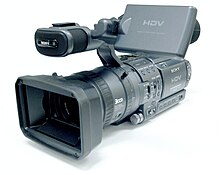Video camera
A video camera is camera used to make electronic motion pictures. It captures moving images and synchronous sound. Early video cameras were all analog and most modern ones are digital. Analog video cameras produce signals that can be displayed with analog televisions. The signals can be shown at the time, or can be stored in an analog format on magnetic tape. Digital video cameras produce digital images.


Video cameras were invented early in the 20th century for television use, and by the end of the century, people could buy digital video cameras, which can almost immediately display the image. Video recorders that could record the image on magnetic tape were created in the middle 20th century.
At first, video cameras were large and expensive. Only professionals operated them. As the electronics industry advanced, and solid state circuits with transistors and microprocessors replaced vacuum tubes, video cameras became smaller and inexpensive. Now many mobile phones and other consumer electronic devices include video cameras. In addition, software is now widely available to edit or to compress the output from video cameras.
Uses
changeModern video cameras have numerous designs and uses, not all of which resemble the early television cameras.
- Professional video cameras, such as those used in television production and sometimes filmmaking in digital cinema; these may be studio-based or mobile in the case of an electronic field production (EFP). Such cameras generally offer extremely fine-grained manual control for the camera operator, often to the exclusion of automated operation.
- Camcorders, which combine a camera and a VCR or other recording device in one unit; these are mobile, and are widely used for television production, home movies, electronic news gathering (ENG) (including citizen journalism), and similar applications. Some digital ones are
- Pocket video cameras.
- Closed-circuit television (CCTV) generally use pan tilt zoom cameras (PTZ), for security, surveillance, and/or monitoring purposes. Such cameras are designed to be small, easily hidden, and able to operate unattended; those used in industrial or scientific settings are often meant for use in environments that are normally inaccessible or uncomfortable for humans, and are therefore hardened for such hostile environments (e.g. radiation, high heat, or toxic chemical exposure).
- Webcams are video cameras which stream a live video feed to a computer. Larger video cameras (especially camcorders and CCTV cameras) can be similarly used, though they may need an analog-to-digital converter in order to store the output on a computer or digital video recorder or send it to a wider network.
- Most 21st century video cameras are digital cameras which convert the signal directly to a digital output; such cameras are often small, even smaller than CCTV security cameras, and are often used as webcams or optimized for still-camera use. The majority are incorporated directly into computer or communications hardware, particularly mobile phones, though analog video equipment remains in use.
- Special systems, like those used for scientific research, e.g. in an observatory or satellite or spaceprobe, or in artificial intelligence and robotics research. Such cameras are often tuned for non-visible radiation for infrared photography (for night vision and heat sensing) or X-ray (for medical use).
Special uses of video cameras include systems that capture images at the finish line to time races and sporting events. Some toll roads use video cameras to make pictures of the license plate of any car that fails to pay tolls. Computers then identify the drivers and mail enforcement letters to collect the missed tolls.